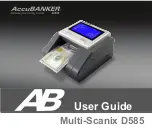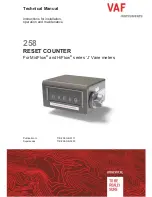
10
5.5.4 Setting the individual width detection (optional)
If the
"LEVEL"
button is pressed once, the value
"AUF"
appears in the stack display (see
fig. 11).
The device now individually detects the width of the notes. The width of the first banknote
acts as the control value. The sensitivity can be set by pressing the
"LEVEL"
button. If
pressed once, the value
"LE1"
appears on the display (see fig. 12).
"LE"
in this case
represents the width.
"1"
is the lowest value. More sensitive settings can also be selected
-
"LE2", "LE3"
and
"LE4".
The device saves this setting after 1.5 seconds and switches to stand-by mode.
Fig. 12
Fig. 12
5.6 External display (optional)
• Connect the external display via the connection on the device.
• The external display shows the same value as the counter on the device.
6.0 SETTINGS
6.1 Setting the banknote feed
• The feed needs to be removed to allow adjustments to be made. First release the retai-
ning screw on the back cover. Carefully open the cover and release the retaining screw
of the banknote feed. Turn the adjustment screw of the feed anticlockwise. Carefully pull
the banknote feed back.
COMMENT:
Only pull the banknote feed out a little so that the sensor cable below the feed board
is not pulled out.
• The two springs on either side of the front of the feed can now be released. The banknote
feed cannot be freely moved.
• By turning the feed adjustment clockwise the gap between the banknote feed wheel and
the rubber resistance disc is increased and the resistance thereby reduced. Turning the
adjustment screw anticlockwise allows the gap to be reduced again.
-BJ05_Anleitung engl. 01.11.2006 8:30 Uhr Seite 10





























